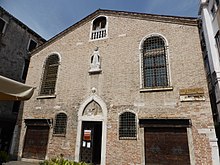Scoletta dei Calegheri
| Venice and its lagoon | |
|---|---|
|
UNESCO world heritage |
|

|
|
| Scoletta dei Calegheri, relief above the entrance: St. Mark heals the Alexandrian shoemaker Anianus |
|
| National territory: |
|
| Type: | Culture |
| Criteria : | i, ii, iii, iv, v, vi |
| Reference No .: | 394 |
| UNESCO region : | Europe and North America |
| History of enrollment | |
| Enrollment: | 1987 (session 11) |
The Scoletta dei Calegheri (or Scuola dei Calegheri ) is a historic building on Campo San Tomà in Venice . She was among the small Venetian Scuole .
history
The guild of shoemakers and cobblers ( calegheri e zavatteri ) acquired the building in 1446 and, according to the inscription, restored it in 1478.
The hall on the upper floor now serves as the public library (Biblioteca di San Tomà) and can be visited during opening hours.
Building description
The building is Gothic . The shops on the ground floor are the result of later renovations.
In the central axis of the façade, which points to Campo San Tomà, a protective cloak Madonna is depicted in high relief between two large windows on the first floor . This 14th century work of art comes from the demolished church of Santa Maria dei Servi. It was only added at this point in 1928.
Below is the main entrance. The lunette above the portal has been adorned with a bas-relief attributed to Pietro Lombardo since the renovation in 1479 . In the years 2002 to 2003 this relief was cleaned and remnants of the original painting and gilding came to light. Depicted is the evangelist Mark (the patron saint of Venice) who, on his arrival in Alexandria, heals the cobbler Anianus (the patron of the guild). The fact that the conversion of Anianus is a main part of the St. Mark's legend was of great importance to the Venetian cobbler and cobbler guild. Anianus wears the contemporary oriental costume, so he looks like a Muslim. In contrast to other European merchants, Venetians were continuously present in the Muslim cities of the Middle East and gave the artists of their hometown a good knowledge of the way of life there, for which this relief, as well as the relief of the Scuola Grande di San Marco , which the same scene for Topic can be used as an example.
The lintel shows the inscription made on the occasion of the renovation with three shoes depicted in relief.
The upper floor, the former assembly room of the guild, has a number of frescoes from the 15th century. It shows the Annunciation and scenes from the lives of the saints, including St. Mark and St. Anianus in Alexandria.
Web links
- Conoscere Venezia: Scuola dei calegheri (calzolai) sotto l'invocazione di Sant'Aniano
literature
- Antonio Manno: Venice (National Geographic Art Guide). Hamburg 2004, ISBN 3-934385-95-8
- Touring Club Italiano: Venezia . ISBN 88-365-0006-4
- Institute du Monde Arabe, Metropolitan Museum of Art (Ed.): Venice and the Islamic World, 828–1797 . Yale University Press, 2007.

